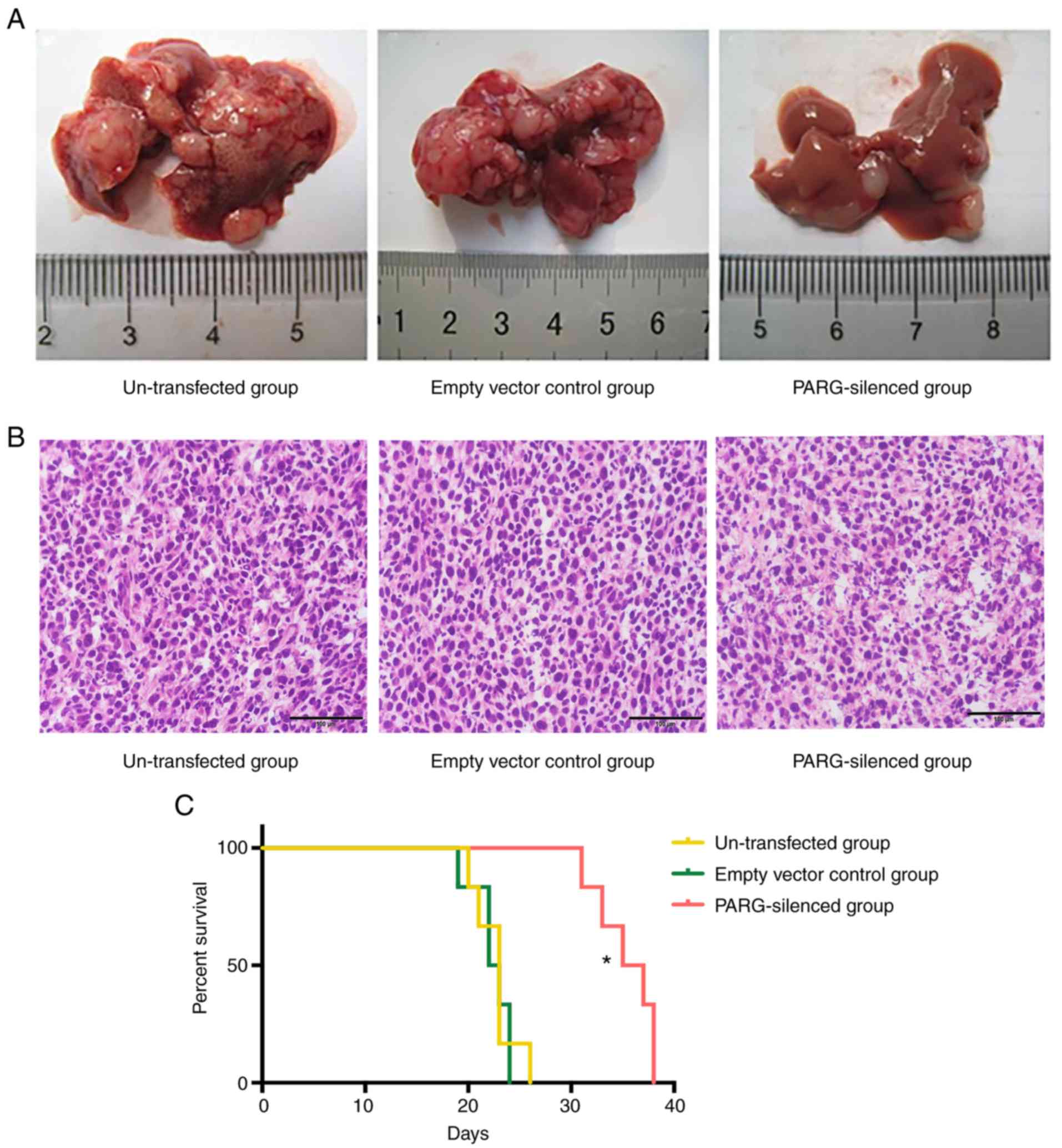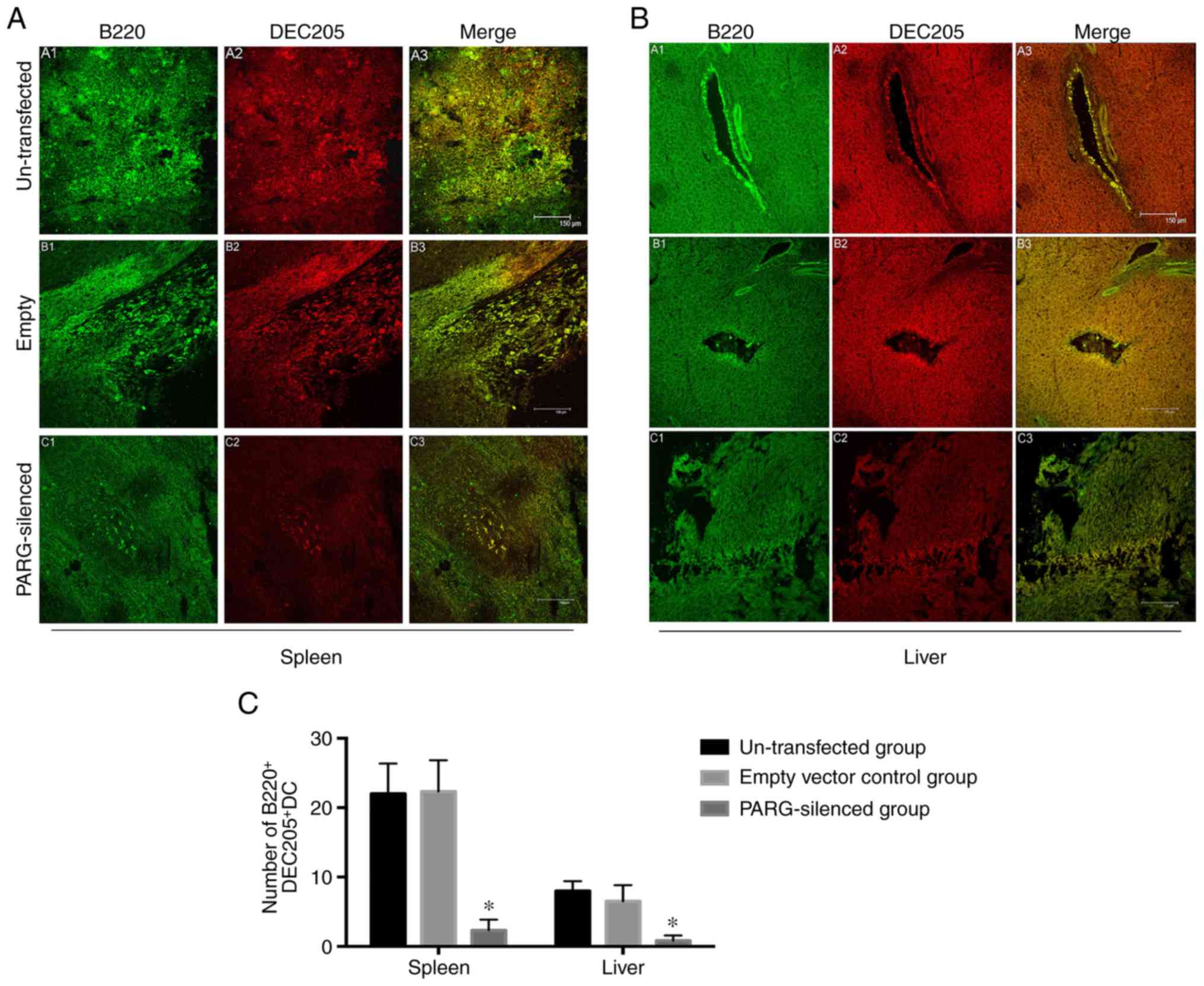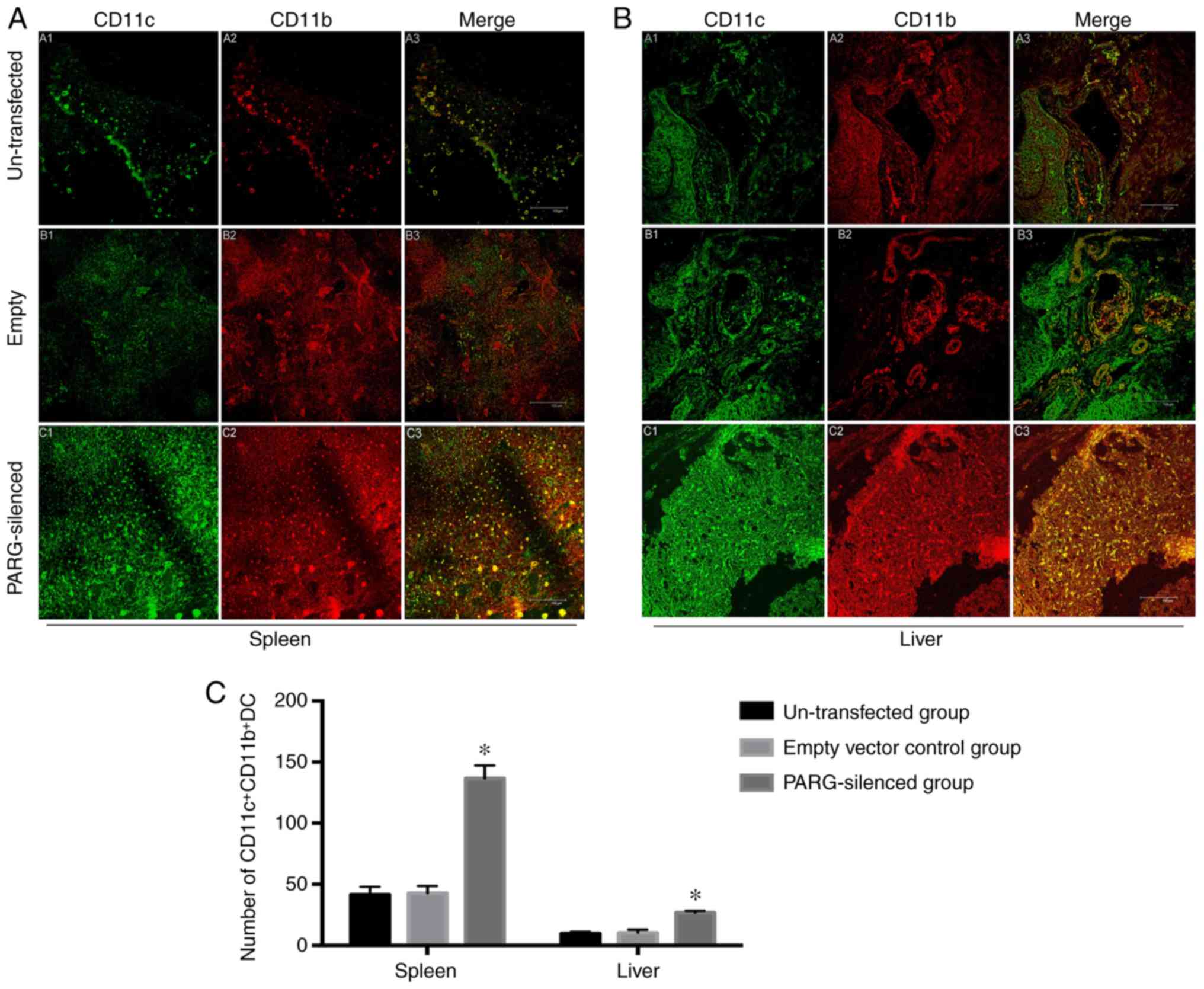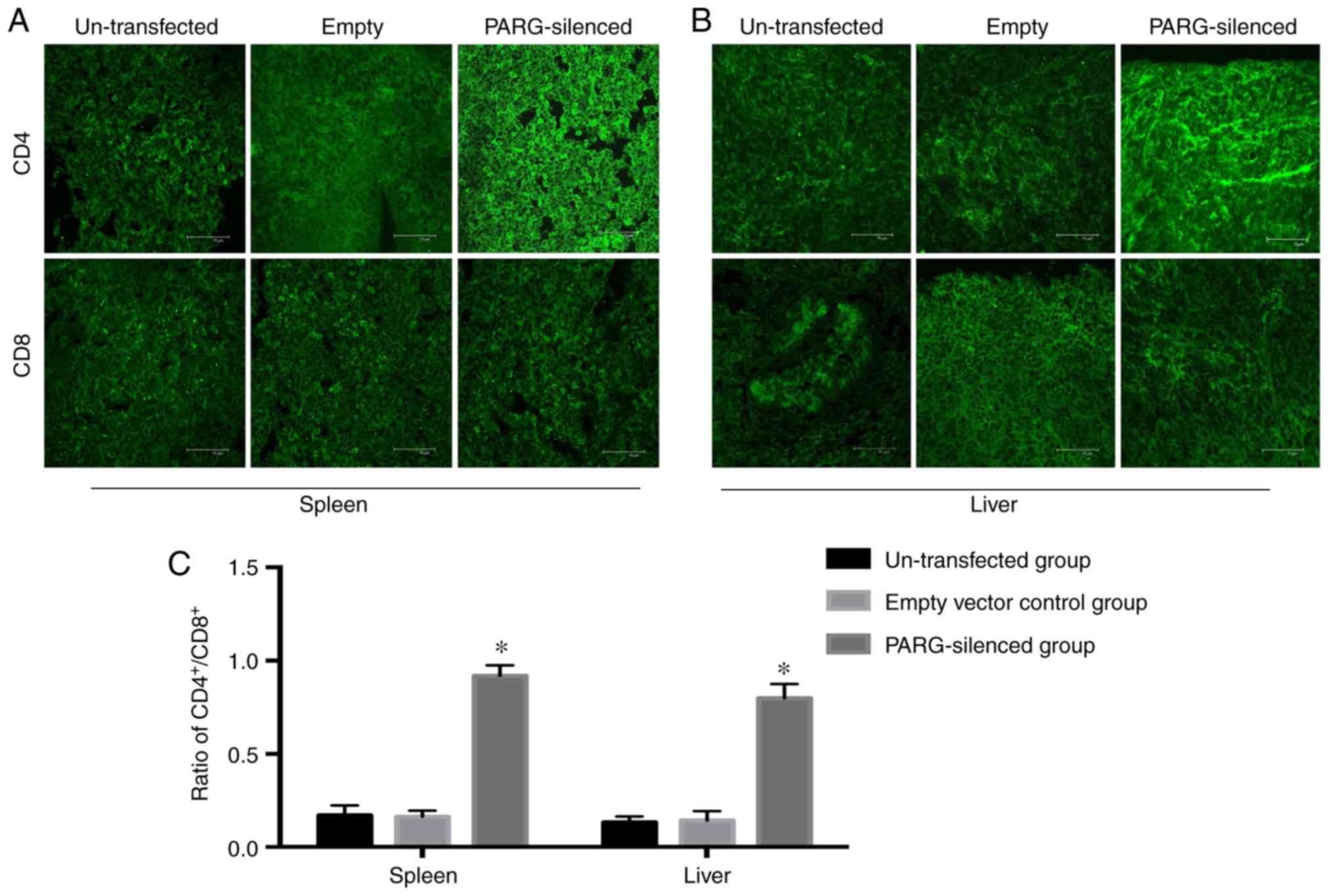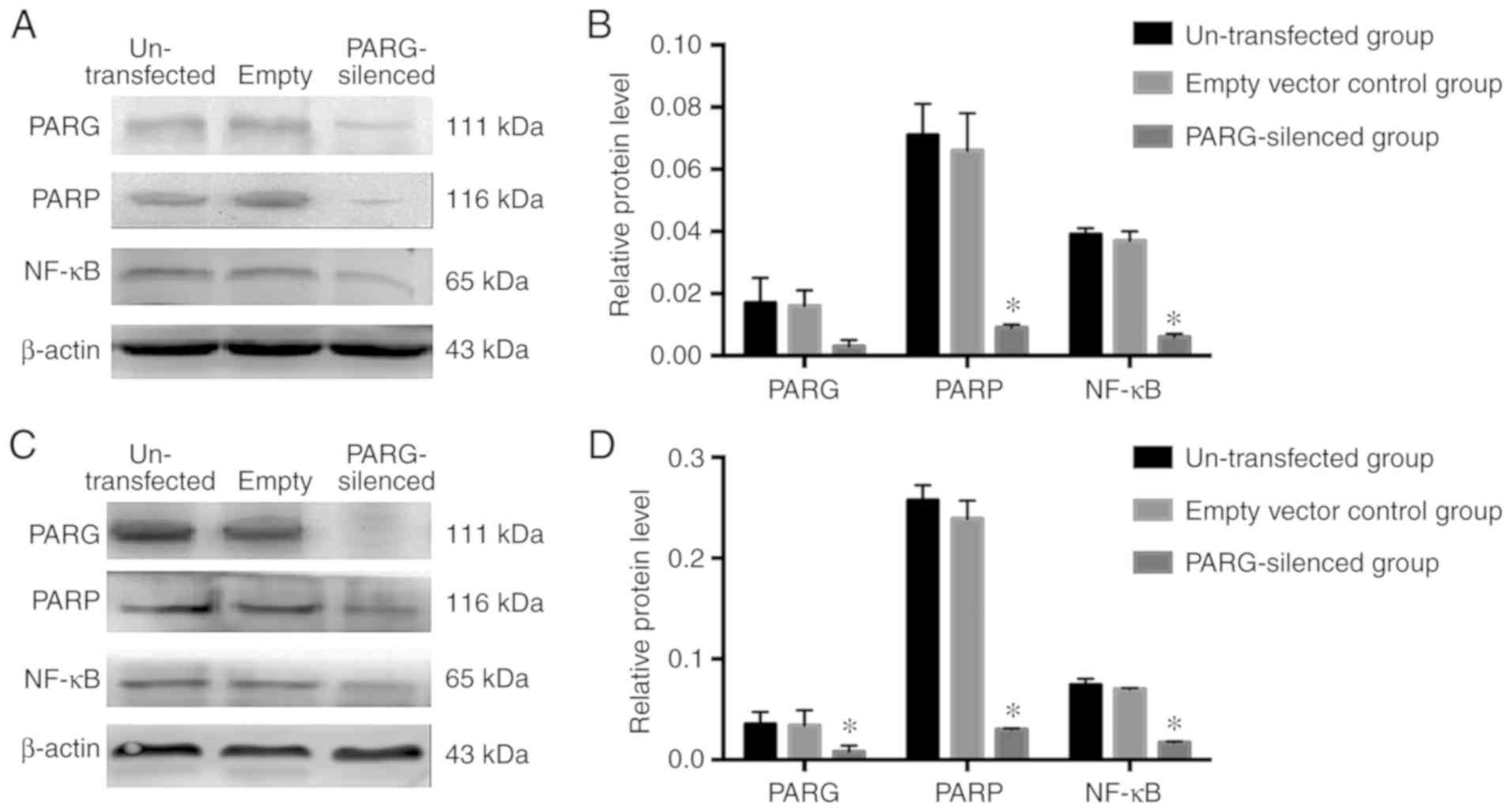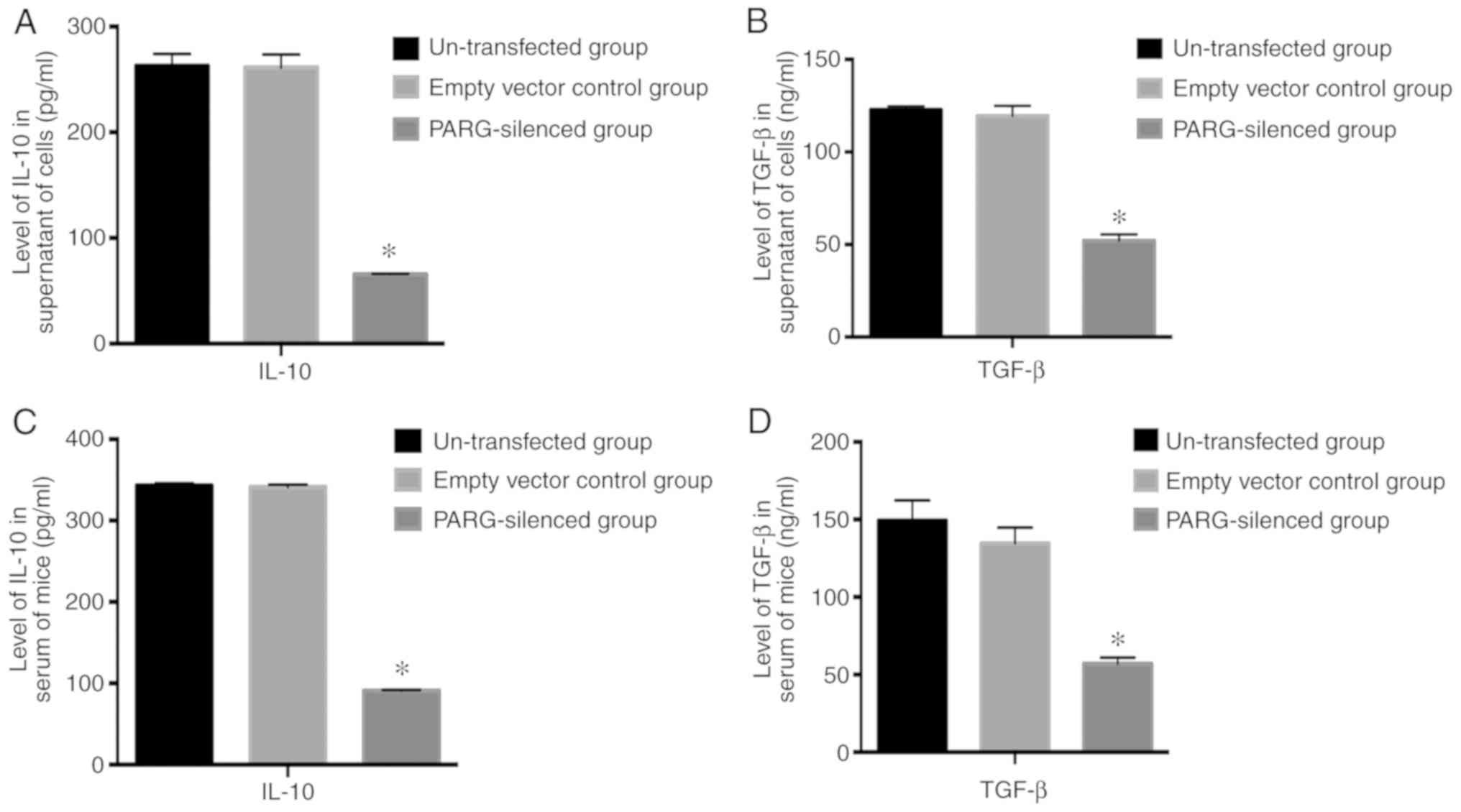PARG regulates the proliferation and differentiation of DCs and T cells via PARP/NF‑κB in tumour metastases of colon carcinoma
- Authors:
- Published online on: March 7, 2019 https://doi.org/10.3892/or.2019.7051
- Pages: 2657-2666
-
Copyright: © Wang et al. This is an open access article distributed under the terms of Creative Commons Attribution License.
Abstract
Introduction
Colon carcinoma is one of the most common types of malignant tumours, with a high mortality rate due to early metastases. On the one hand, metastases of colon carcinoma are connected with the metastatic potential of tumour cells, but on the other hand, it is also closely related to the body's immune response (1). Many tumours are associated with immune dysfunction. T lymphocytes are generally considered the core of tumour immunity (2). CD4+T cells mainly comprise auxiliary T cells that contain T helper 0 (Th0), T helper 1 (Th1), and T helper 2 (Th2) subsets. Th0 cells differentiate into Th1 cells that could stimulate the immune response and Th2 cells that can induce peripheral immune tolerance by the stimulation of various cytokines. Additionally, some CD4+T cells act as regulatory T cells (T-reg) that induce peripheral immune tolerance. CD8+T cells are mainly cytotoxic T cells, and some CD8+T cells are T-reg cells that not only induce cytotoxic effects on target cells, but also inhibit the activation/proliferation of CD4+T cells. Maintaining the dynamic balance of the CD4+/CD8+ ratio serves an important role in the stability of immune function. It has been identified that a patient's immune function is reduced when the CD4+/CD8+ ratio decreases, resulting in tumour proliferation (3).
As the most powerful antigen-presenting cells (APCs), dendritic cells (DCs) can directly activate naïve T cells to differentiate into auxiliary and cytotoxic T cells, thereby serving an important role in the immune response system (4). DCs originate from bone marrow precursors and include two distinct lineages, myeloid DCs (or DC1), which express myeloid markers (such as CD11c and CD11b), and plasmacytoid DCs (or DC2), which lack myeloid markers and express lymphoid markers CD123 (or B220) and DEC205 (3–6). DCs affect the differentiation and proliferation of CD4+T cells and CD8+T cells. DC1 cells mainly induce the differentiation of CD4+T cells into Th1 to stimulate the immune response, whereas DC2 cells mainly promote the differentiation of Th2 or T-reg and are dedicated to the progression of peripheral immune tolerance (7). A previous study reported that the number of DCs in the peripheral blood of patients with colon carcinoma is significantly reduced and that the number of CD11c+DCs is markedly lower than that of CD123+DCs when there is distant metastasis (8). In mammary carcinomas, purified CD11b+CD11c+ myeloid cells can enhance inducible nitric oxide synthase (iNOS) expression in tumour cells to promote tumour cell apoptosis (9). Our previous study suggested that B220+DEC205+DCs induced from the mouse liver can promote liver metastasis of colon carcinoma (10). All these results suggest that DCs in the tumour microenvironment have intimate relationships with tumour immunity and that DCs can induce different tumour immunity according to the DC phenotype to further affect the growth and metastasis of tumours.
Poly(ADP-ribose) glycohydrolase (PARG) and poly(ADP- ribose) polymerase (PARP) are closely related to the occurrence and development of inflammation, ischaemia-reperfusion injury, cancer and other diseases. Silencing PARG can reduce cell proliferation and increase the sensitivity of cells to toxicity, thus inhibiting embryonic development (11). Knocking out the PARG gene in the mouse enteritis model inhibits the progression of bowel tissue inflammation (12). Our previous research findings demonstrated that PARG silenced in the colon carcinoma mouse model can suppress the matrix adhesion, movement and attack ability of human colon carcinoma LoVo cells (13) so that the growing, invasion and metastasis of LoVo cells were effectively inhibited (14). Nevertheless, the role of PARG in immune function and how it affects the invasion and metastasis of tumours has not been investigated.
In the present study, a liver metastasis model of colon carcinoma was established in mice with the inoculation of PARG-silenced CT26 cell lines obtained by transfecting CT26 cell lines with a lentivirus vector containing PARG-short hairpin RNA (shRNA) to observe tumour metastases and the survival times of tumour-bearing mice, to determine the effect of silencing PARG on the proliferation and differentiation of local DCs and T cells and the possible underlying mechanisms, and to explore the impact of PARG on immune function in invasion and metastasis of colon carcinoma to identify a new target in the clinical treatment of anti-colon carcinoma.
Materials and methods
Mice
A total of 48 female BALB/c mice were purchased from the Animal Experimental Center of Chongqing Medical University (Chongqing, China; certification no. 20020001). All mice were maintained in the specific pathogen-free facility (SPF) room (20–26°C, 12-h light/12-h dark cycle) and were inoculated with tumour cells at a weight of 18–20 g and 6–8 weeks of age. Experiments were performed at the SPF Animal Laboratory.
Cell transfection
The colon carcinoma CT26 cell line was a gift from Professor Wei (Sichuan University, Chengdu, China). According to the specification of the lentivirus transfection reagent (Sigma; Merck KGaA, Darmstadt, Germany), lentivirus PARG-shRNA was transfected into CT26 cells and screened to obtain stable PARG-silenced CT26 cells by Dr SWeiqiang Wu in our laboratory (15). Untreated CT26 cells served as the non-transfected group, CT26 cells treated with empty vector served as the empty vector control group, and CT26 cells transfected with lentivirus PARG-shRNA served as the PARG-silenced group. Routine culture for each CT26 cell group was performed, and the culture supernatant was collected.
Establishment of mouse models for liver metastases of colon carcinoma
According to the method of Liu et al (16), 48 BALB/c mice were randomly divided into the non-transfected group, empty vector control group and PARG-silenced group. Each CT26 cell group in exponential growth was collected and mixed with PBS into a suspension (1×107 cells/ml). The mice were anaesthetized with 2% chloral hydrate (16 ml/kg) by injection into the abdominal cavity, followed by an abdominal wall incision parallel to the left subcostal margin. Laparotomy was performed, and then, splenic subcapsular inoculation of 0.05 ml of each CT26 cell suspension was performed. The incision was then sewn with a #1 suture. After 14 days, 10 mice were randomly chosen and assigned to each group. The abdominal cavity was opened to observe and record the number of liver metastases of colon carcinoma nodules and whether the nodules were fused. Liver metastasis was divided into 4 grades according to the following description: grade 0, no liver metastases; grade I, 1–5 liver metastasis nodules; grade II, 6–10 liver metastasis nodules; grade III, >10 liver metastasis nodules (14). The spleen and liver tissues were preserved in liquid nitrogen, and the supernatant of the blood was stored at −80°C. The survival time of the remaining tumour-bearing mice were recorded daily.
Detection of liver metastases of colon carcinoma by haematoxylin and eosin (H&E) staining
Liver metastases of colon carcinoma were frozen at −20°C for 30 sec and then sliced into 8-µm thick sections at −20°C using a freezing microtome (Thermo Fisher Scientific, Inc., Waltham, MA, USA), fixed with methanol and successively immersed in different levels of ethanol for hydration. Following immersion of the specimens in xylene, the specimens were washed with water. The specimens were stained with haematoxylin for 5 sec at room temperature, dipped in Neurolithium for 2 sec and then stained with eosin. Each coverslip was detected by microscopy at ×400 magnification (Olympus Corporation, Tokyo, Japan).
Double-label immunofluorescence assay
Spleen or liver frozen sections were fixed with acetone for 5 min and were incubated with bovine serum albumin (BSA) for 30 min at 37°C. The spleen or liver sections were first incubated with anti-DEC205 antibody (cat. no. ab51820; 1:50 diluted in PBS; Abcam, Cambridge, MA, USA) or anti-CD11b antibody (cat. no. sc-1186; 1:50 diluted in PBS; Santa Cruz Biotechnology, Inc., Dallas, TX, USA), followed by the addition of anti-B220 antibody (cat. no. bs-10599R; 1:100 diluted in PBS; BIOSS, Beijing, China) or anti-CD11c antibody (cat. no. bs-2508R; 1:50 diluted in PBS; BIOSS) at 4°C overnight. Phycoerythrin (PE)-conjugated streptavidin anti-biotin (cat. no. bs-0437P-PE; 1:50 diluted in PBS; BIOSS), cyanine 3 (Cy3)-conjugated donkey anti-goat (cat. no. A0502; 1:50 diluted in PBS; Beyotime Institute of Biotechnology, Haimen, China), fluorescein isothiocyanate (FITC)-conjugated goat anti-rabbit (cat. no. bs-0295G-FITC; 1:100 diluted in PBS; BIOSS) and FITC-conjugated mouse anti-rabbit (cat. no. bs-0293M-FITC; 1:50 diluted in PBS; BIOSS) were used as secondary antibodies (1 h, 37°C, incubated in the dark). Negative controls were performed with PBS instead of primary antibody. Images of the sections were captured and analysed by confocal laser-scanning microscopy (Leica TCS SP2; Leica Microsystems GmbH, Wetzlar, Germany) at ×400 magnification.
Immunofluorescence assay
Spleen or liver frozen sections were fixed with acetone for 5 min and incubated with goat serum for 30 min at 37°C. Spleen or liver sections were incubated with anti-CD4 antibody (cat. no. bs-0766R; 1:50 diluted in PBS; BIOSS) or anti-CD8 antibody (cat. no. bs-0648R; 1:50 diluted in PBS; BIOSS) at 4°C overnight. FITC-conjugated goat anti-rabbit IgG (cat. no. bs-0295G-FITC; 1:50 diluted in PBS; BIOSS) was used as the secondary antibody (1 h, 37°C, incubated in the dark). Negative controls were performed with PBS instead of primary antibody. Images of the sections were captured and analysed by confocal laser-scanning microscopy at ×200 magnification.
Western blotting
The tumour tissues of the spleen or liver preserved in liquid nitrogen were lysed with radioimmunoprecipitation buffer (cat. no. P0013K; Beyotime Institute of Biotechnology) and the supernatant was collected by centrifugation at 22,351 × g for 20 min at 4°C. The total protein or nucleoprotein concentration was determined using a bicinchoninic acid assay kit (Biomed Gene Technology Co., Ltd., Beijing, China), according to the manufacturer's protocol. The total proteins using specific antibodies against PARG (cat. no. ab169639; 1:1,000 dilution; Abcam) and nucleoproteins using NF-κB (cat. no. sc-1190; 1:1,000 dilution; Santa Cruz Biotechnology, Inc.) and PARP (cat. no. sc-136208; 1:1,000 dilution; Santa Cruz Biotechnology, Inc.) were analysed by western blotting. Using vertical slab PAGE, the protein was electrically transferred onto polyvinylidene fluoride (PVDF) membranes. The membranes were then blocked with TBST (10 mM Tris/HCl, pH 7.4, 150 mM NaCl and 0.1% Tween-20) containing 5% non-fat dry milk and were incubated with the primary antibody at 4°C overnight. Following washing with PBS, the membranes were incubated with the secondary antibody for 2 h at room temperature and then dipped into enhanced chemiluminescent substrates (GE Healthcare, Chicago, IL, USA) and images were captured using a gel-imaging system (Bio-Rad Laboratories, Inc., Hercules, CA, USA). Finally, Quantity One software (version 4.5; Bio-Rad Laboratories, Inc.) was used for the densitometric analysis of proteins.
ELISA
IL-10 and TGF-β in the serum of tumour-bearing mice and supernatant of tumour cells were assayed using ELISA kits (cat. nos. DY417 and DY1679; R&D Systems, Inc., Minneapolis, MN, USA) according to the manufacturer's protocol. The optical density (OD) at 450 nm was measured using an automated reader (Bio-Tek Instruments, Inc., Winooski, VT, USA). A standard curve was plotted, and a formula was used to fit the OD of the standard samples. The lower limits of detection of these assays were as follows: IL-10, 30–700 pg/ml; and TGF-α, 10–200 ng/ml.
Statistical analysis
Statistical analysis was performed using SPSS 19.0 software (SPSS, Chicago, IL, USA). The data were expressed as the means ± standard error of the mean. The grade of liver metastasis carcinoma nodules was analysed by the Kruskal-Wallis and Nemenyi methods. The survival data were estimated by the Kaplan-Meier method and were compared by the log-rank test. One-way ANOVA and the least significant difference (LSD) test were used for many sets of the data. P<0.05 was considered to indicate a statistically significant difference.
Results
Number and grade of liver metastases of colon carcinoma nodules
No mouse succumbed during the 2-week experimental period. There were carcinoma nodules on the inoculated parts of the spleen in all mice, many of them single nodules. The liver metastatic rates of the non-transfected group, empty vector group and PARG-silenced group were 100, 100, and 30%, respectively. The number and grade of liver metastases in the PARG-silenced group were significantly less than those in the control groups (P<0.05; Table I; Fig. 1A). There was no significant difference between the non-transfected group and empty vector control group (P>0.05). The liver metastasis carcinoma nodules were staining with H&E (Fig. 1B).
Survival time
The survival time of the remaining tumour- bearing mice in multiple groups was calculated from the day that the mice were inoculated with CT26 cells to their natural death. The survival ratio was represented as the vertical axis and time following inoculation as the horizontal axis to draw the survival curves. The survival time of the PARG-silenced group was remarkably longer than that in the control groups by the log-rank test (P<0.05) (Fig. 1B). There was no significant difference between the non-transfected group and the empty vector control group (P>0.05).
Numbers of B220+DEC205+DCs and CD11c+CD11b+DCs in the spleen and liver
Double-label immunofluorescence staining for B220 and DEC205 or CD11c and CD11b was performed on DCs within the spleen and liver frozen sections to determine the change in the immune status following PARG silencing. The numbers of B220+DEC205+DCs in the spleen and liver were significantly fewer in the PARG-silenced group than in the control groups (P<0.05; Fig. 2A-C), but an obviously increased amount of CD11c+CD11b+DCs was seen in the spleen and liver of the PARG-silenced group compared to that of the control (P<0.05; Fig. 3A-C). There was no significant difference between the non-transfected group and the empty vector control group (P>0.05).
Ratio of CD4+/CD8+ in the spleen and liver
Single-staining immunofluorescence was employed to detect CD4 or CD8 cells in T cells within the spleen and liver and determine the change in immune function following PARG was silenced. The number of CD4+T cells in the spleen and liver of the PARG-silenced group was more than that in the control group, but the number of CD8+T cells in the PARG-silenced group and control group exhibited no difference. Therefore, the ratio of CD4+/CD8+ in the spleen and liver was increased in the PARG-silenced group compared with that in the control group (P<0.05; Fig. 4A-C). There was no significant difference between the non-transfected group and empty vector control group (P>0.05).
Expression of PARG, PARP and NF-κB of the spleen transplant tumour and liver metastases of colon carcinoma
The expression levels of PARG, PARP and NF-κB proteins in spleen transplant tumours were decreased in the PARG-silenced group than in the control groups (P<0.05; Fig. 5A and B). In liver metastases of colon carcinoma, the expression levels of PARG, PARP and NF-κB were decreased compared with those in the control groups (P<0.05; Fig. 5C and D). There was no significant difference between the non-transfected group and empty vector control group (P>0.05).
Influence of silencing PARG on IL-10 and TGF-β
The secretion of IL-10 and TGF-β in the supernatant of PARG-silenced CT26 cells was significantly decreased compared with non-transfected CT26 cells and empty vector control CT26 cells (P<0.05; Fig. 6A and B). The levels of IL-10 and TGF-β in serum were also reduced in the PARG-silenced group compared with those in the non-transfected group and empty vector control group (P<0.05; Fig. 6C and D). There was no significant difference between the non-transfected group and empty vector control group (P>0.05).
Discussion
Proper regulation of PARPs1/2 and PARG is required for the cellular responses to genotoxic stress, and PARG serves an important role in regulating the activity of PARP (17). The poly(ADP-ribose) (PAR) degrading enzyme PARG could catalyse PAR turnover via hydrolysis of the α(1″ → 2′) and α(1″′ → 2″) ribosyl-ribose linkages to produce free ADP-ribose (ADPR), and then restore the activity of the poly(ADP-ribosyl)ated PARP-1 by detaching PAR to be recycled for poly(ADP-ribosyl)ation (18,19). Frizzell et al (20) demonstrated that PARG serves a vital role not only in the regulation of PARP but also in adjusting the expression of downstream genes by collaborating with PARP. Therefore, we hypothesize that PARG repression served as an effective method to inhibit PARP. Chandak et al (21) indicated that the expression of PARP was reduced when the expression of PARG was inhibited by a specific inhibitor of PARG tannins. In our previous in vitro studies, silencing PARG in colon carcinoma cells reduces the expression of PARP (13,14). In the present study, a liver metastasis model of colon carcinoma was established in mice with inoculation of PARG-silenced CT26 cell lines. The expression of PARG was revealed to be reduced, and the expression of PARP was also decreased in spleen transplant tumours and liver metastases of colon carcinoma.
As a pleiotropic transcription factor, NF-κB activates the transcription of >500 genes and participates in the regulation of the expression of many genes related to inflammation, cellular transformation, tumour cell survival, proliferation, invasion, angiogenesis and metastasis (22). The most common NF-κB dimer (p50/p65) is found in all the members of NF-κB family. The change in the content of NF-κB to speculate the variation of NF-κB activity has been reported in several studies (23–25). Our previous study indicated that PARP-1 could regulate the activity of NF-κB by which PARP-1 influences the activation of TLR4-associated signal transduction, leading to NF-κB activation and subsequent nuclear retention (26). Suppressing the expression of PARP could further control the activity of NF-κB through the phosphoinositide 3-kinase (PI3K)/protein kinase B (Akt) signalling pathway in several diseases, including tumours or non-tumours (27–29). Our previous in vitro study indicated that PARG silencing could reduce the expression of PARP and inhibit the activity of NF-κB at the same time (13,14). In our in vivo experiment, the levels of PARP and NF-κB in spleen transplant tumours and liver metastases of colon carcinoma are reduced following PARG silencing.
As the downstream factor of NF-κB, IL-10 and TGF-β are considered cytokines with immunosuppressive activity. They have a wide range of biological effects, including regulating immunocyte and non-immune cell activation, proliferation and differentiation (30–34). Our previous studies have indicated that PARG silencing in colon carcinoma cells could reduce the expression of PARP as well as inhibit the transcription of NF-κB, thereby inhibiting tumour metastasis (13,14). This conclusion is supported by the results that the expression levels of PARP and NF-κB in the spleen transplant tumour and liver metastases of colon carcinoma were depressed following PARG silencing, the secretion of IL-10 and TGF-β in the supernatant of PARG-silenced CT26 cells was decreased, and the levels of IL-10 and TGF-β in the serum of PARG-silenced tumour-bearing mice were also reduced. These results suggest that PARG silencing in colon carcinoma can regulate the secretion of IL-10 and TGF-β through adjusting the activity of NF-κB. Further studies are needed to uncover the underlying mechanism.
Accumulating evidence has suggested that DCs may serve an important role in tumour immunity (35). The number and function of DCs in tumour tissue are closely related to the occurrence, development, transfer and prognosis of cancer (36). Initially, DEC205+B220+CD19−DCs were induced from the liver in vitro by Lu et al (37). That this subtype of DCs could prolong the cardiac allograft survival time suggests that they may serve an active role in tolerance induction and maintenance in this model (37). B220+DEC205+DCs were induced from mice and it was identified that they are associated with the immune tolerance of liver transplantation through regulating the proliferation and differentiation of lymphocytes (38). It was also identified that B220+DEC205+DCs can promote the liver metastasis of colon carcinoma and speculated that they seem closely linked to the regulation of DCs to T-subset differentiation (10). Other studies have also reported that CD11b+CD11c+DCs, which can induce specific immune activity, could promote tumour cell apoptosis to inhibit tumour metastasis (9).
CD4+T cells have a major role in secondary immune response via recognizing the exogenous antigen peptide presented by the MHC class II molecules, while CD8+T cells participate in the primary immune response via recognizing the endogenous antigen peptide presented by MHC class I molecules. A steady ratio of CD4+/CD8+ is important in maintaining the normal immune response (39). Studies have demonstrated that the proportion of CD4+T cells and the ratio of CD4+/CD8+ are reduced with an increase in TNM staging (40,41).
The change in DCs and T cells in the local area of tumours is related to the effect on their proliferation and differentiation by both IL-10 and TGF-β secreted by the tumour cells. TGF-β is a potent regulatory cytokine that not only can regulate the proliferation and differentiation of APCs, mast cells, NK cells, NKT cells, CD4+T cells and CD8+T cells but can also regulate the expression of DCs at the transcription and translation levels by the activation of NF-κB via PI3K/Akt phosphorylation or the noncanonical pathway (42–44). IL-10, as an important immunomodulatory and anti-inflammatory cytokine, can adjust the proliferation and differentiation of DCs as well as directly affect the function of T cells (45,46). However, no data have indicated whether PARG silencing in colon carcinoma can inhibit the expression of PARP and, thus, restrain the activity of NF-κB, downregulate the secretion of downstream factor IL-10 and TGF-β, and then influence the proliferation and differentiation of DCs and T cells, finally inhibiting the metastases of colon carcinoma by the change in immunity function.
In the present study, the effect of PARG on DCs and T cells was observed in the spleen and liver of tumour-bearing mice. The results indicated that in the PARG-silenced group, the number of B220+DEC205+DCs was reduced, but the level of CD11c+CD11b+DCs was increased in the spleen and liver of tumour-bearing mice, with an increased ratio of CD4+/CD8+ cells. Thus, IL-10 and TGF-β regulated by PARG could promote the differentiation of DCs into the immunoreactive subset and further influence the differentiation of T cells. It is concluded that silencing the PARG gene in CT26 cells could suppress the metastasis of tumour cells to the liver in colon carcinoma and prolong the survival time of the tumour-bearing mice. This effect is probably related to the downregulation of PARP by PARG silencing and inhibition of NF-κB activity, further reducing the secretion of IL-10 and TGF-β and influencing the proliferation and differentiation of DCs and T cells. Briefly, the results of the present study imply that PARG could serve an important role in the growth of tumours and metastasis to the liver of colon carcinoma and may serve as a new target for clinical colon carcinoma therapy. The underlying mechanism concerning the immune function requires further research.
Acknowledgements
The authors thank Professor YQ Wei (Sichuan University, Chengdu, China) for providing the CT26 cell line.
Funding
The present study was supported by the National Nature Science Foundation of China (grant no. 30870946).
Availability of data and materials
The datasets used and/or analysed during the present study are available from the corresponding author on reasonable request.
Authors' contributions
JQW performed the experiments and wrote the first draft of the paper. YT analyzed the data and edited the manuscript prior to acceptance. QSL produced the figures, organized the references and performed the H&E staining to detect the liver metastasis of colon carcinoma. MX performed the double-label immunofluorescence assay. ML performed the western blot analysis. YY and YTS participated in the construction of the transplanted tumour model in BALB/c mice. YLW designed and performed the experiments. All authors read and approved the final manuscript.
Ethics approval and consent to participate
The present study was approved by the Ethics Committee of Chongqing Medical University (Chongqing, China).
Patient consent for publication
Not applicable.
Competing interests
The authors declare that they have no competing interests.
References
|
Kubota Y, Sunouchi K, Ono M, Sawada T and Muto T: Local immunity and metastasis of colorectal carcinoma. Dis Colon Rectum. 35:645–650. 1922. View Article : Google Scholar | |
|
Yasutomo K: The cellular and molecular mechanism of CD4/CD8 lineage commitment. J Med Invest. 49:1–6. 2002.PubMed/NCBI | |
|
Lonial S, Torre C, David E, Harris W, Arellano M and Waller EK: Regulation of alloimmune responses by dendritic cell subsets. Exp Hematol. 36:1309–1317. 2008. View Article : Google Scholar : PubMed/NCBI | |
|
Fassbender M, Herter S, Holtappels R and Schild H: Correlation of dendritic cell maturation and the formation of aggregates of poly-ubiquitinated proteins in the cytosol. Med Microbiol Immunol. 197:185–189. 2008. View Article : Google Scholar : PubMed/NCBI | |
|
Zarnani AH, Moazzeni SM, Shokri F, Salehnia M and Jeddi-Tehrani M: Kinetics of murine decidual dendritic cells. Reproduction. 133:275–283. 2007. View Article : Google Scholar : PubMed/NCBI | |
|
Sato K and Fujita S: Dendritic cells-nature and classification. Allergol Int. 56:183–191. 2007. View Article : Google Scholar : PubMed/NCBI | |
|
Reid SD, Penna G and Adorini L: The control of T cell responses by dendritic cell subsets. Curr Opin Immunol. 12:114–121. 2000. View Article : Google Scholar : PubMed/NCBI | |
|
Della Porta M, Danova M, Rigolin GM, Brugnatelli S, Rovati B, Tronconi C, Fraulini C, Russo Rossi A, Riccardi A and Castoldi G: Dendritic cells and vascular endothelial growth factor in colorectal cancer: Correlations with clinicobiological findings. Oncology. 68:276–284. 2005. View Article : Google Scholar : PubMed/NCBI | |
|
Parajuli N, Müller-Holzner E, Böck G, Werner ER, Villunger A and Doppler W: Infiltrating CD11b+CD11c+ cells have the potential to mediate inducible nitric oxide synthase-dependent cell death in mammary carcinomas of HER-2/neu transgenic mice. Int J Cancer. 126:896–908. 2010. View Article : Google Scholar : PubMed/NCBI | |
|
Ke Q, Wang Y and You H: Effect of mouse liver-derived B220+/DEC205+ dendritic cells on hepatic metastases from colonic cancer in vivo. Chin J Anatomy. 32:724–727. 2009.(In Chinese). | |
|
Min W, Cortes U, Herceg Z, Tong WM and Wang ZQ: Deletion of the nuclear isoform of poly(ADP-ribose) glycohydrolase (PARG) reveals its function in DNA repair, genomic stability and tumorigenesis. Carcinogenesis. 31:2058–2065. 2010. View Article : Google Scholar : PubMed/NCBI | |
|
Cuzzocrea S, Mazzon E, Genovese T, Crisafulli C, Min WK, Di Paola R, Muià C, Li JH, Malleo G, Xu W, et al: Role of poly(ADP-ribose) glycohydrolase in the development of inflammatory bowel disease in mice. Free Radic Biol Med. 42:90–105. 2007. View Article : Google Scholar : PubMed/NCBI | |
|
Li QZ, Wang YL and Li X: Lentivirus PARG-shRNA transfection decreases matrix adhesion, migration and invasion potencies of colon carcinoma lovo cells. Basic Clin Med. 30:237–241. 2010.(In Chinese). | |
|
Fauzee NJ, Li Q, Wang YL and Pan J: Silencing poly (ADP-Ribose) glycohydrolase (PARG) expression inhibits growth of human colon cancer cells in vitro via PI3K/Akt/NFκ-B pathway. Pathol Oncol Res. 18:191–199. 2012. View Article : Google Scholar : PubMed/NCBI | |
|
Wu WQ, Wang YL, Pan J and Yan JX: PARG silencing inhibits lymphangiogenesis in mouse colonal carcinoma in vitro. Basic Clin Med. 31:625–629. 2011.(In Chinese). | |
|
Liu HY, Huang ZL, Yang GH, Lu WQ and Yu NR: Inhibitory effect of modified citrus pectin on liver metastases in a mouse colon cancer model. World J Gastroenterol. 14:7386–7391. 2008. View Article : Google Scholar : PubMed/NCBI | |
|
Botta D and Jacobson MK: Identification of a regulatory segment of poly(ADP-ribose) glycohydrolase. Biochemistry. 49:7674–7682. 2010. View Article : Google Scholar : PubMed/NCBI | |
|
Miwa M, Tanaka M, Matsushima T and Sugimura T: Purification and properties of glycohydrolase from calf thymus splitting ribose-ribose linkages of poly(adenosine diphosphate ribose). J Biol Chem. 249:3475–3482. 1974.PubMed/NCBI | |
|
Blenn C, Wyrsch P, Bader J, Bollhalder M and Althaus FR: Poly(ADP-ribose)glycohydrolase is an upstream regulator of Ca2+ fluxes in oxidative cell death. Cell Mol Life Sci. 68:1455–1466. 2011. View Article : Google Scholar : PubMed/NCBI | |
|
Frizzell KM, Gamble MJ, Berrocal JG, Zhang T, Krishnakumar R, Cen Y, Sauve AA and Kraus WL: Global analysis of transcriptional regulation by poly(ADP-ribose) polymerase-1 and poly(ADP-ribose) glycohydrolase in MCF-7 human breast cancer cells. J Biol Chem. 284:33926–33938. 2009. View Article : Google Scholar : PubMed/NCBI | |
|
Chandak PG, Gaikwad AB and Tikoo K: Gallotannin ameliorates the development of streptozotocin-induced diabetic nephropathy by preventing the activation of PARP. Phytother Res. 23:72–77. 2009. View Article : Google Scholar : PubMed/NCBI | |
|
Bannwart CF, Nakaira-Takahagi E, Golim MA, de Medeiros LT, Romao M, Weel IC and Peracoli MT: Downregulation of nuclear factor-kappa B (NF-kappaB) pathway by silibinin in human monocytes challenged with Paracoccidioides brasiliensis. Life Sci. 86:880–886. 2010. View Article : Google Scholar : PubMed/NCBI | |
|
Bar-Shai M, Carmeli E and Reznick AZ: The role of NF-kappaB in protein breakdown in immobilization, aging, and exercise: From basic processes to promotion of health. Ann NY Acad Sci. 1057:431–447. 2005. View Article : Google Scholar : PubMed/NCBI | |
|
Cai D, Frantz JD, Tawa NE Jr, Melendez PA, Oh BC, Lidov HG, Hasselgren PO, Frontera WR, Lee J, Glass DJ, et al: IKKbeta/NF-kappaB activation causes severe muscle wasting in mice. Cell. 119:285–298. 2004. View Article : Google Scholar : PubMed/NCBI | |
|
Hayden MS, West AP and Ghosh S: NF-kappaB and the immune response. Oncogene. 25:6758–6780. 2006. View Article : Google Scholar : PubMed/NCBI | |
|
Zerfaoui M, Errami Y, Naura AS, Suzuki Y, Kim H, Ju J, Liu T, Hans CP, Kim JG, Abd Elmageed ZY, et al: Poly(ADP-ribose) polymerase-1 is a determining factor in Crm1-mediated nuclear export and retention of p65 NF-kappa B upon TLR4 stimulation. J Immunol. 185:1894–1902. 2010. View Article : Google Scholar : PubMed/NCBI | |
|
Bartha E, Solti I, Kereskai L, Lantos J, Plozer E, Magyar K, Szabados E, Kálai T, Hideg K, Halmosi R, et al: PARP inhibition delays transition of hypertensive cardiopathy to heart failure in spontaneously hypertensive rats. Cardiovasc Res. 83:501–510. 2009. View Article : Google Scholar : PubMed/NCBI | |
|
Williams AC, Smartt H, HZadeh AM, MacFarlane M, Paraskeva C and Collard TJ: Insulin-like growth factor binding protein 3 (IGFBP-3) potentiates TRAIL-induced apoptosis of human colorectal carcinoma cells through inhibition of NF-kappa B. Cell Death Differ. 14:137–145. 2007. View Article : Google Scholar : PubMed/NCBI | |
|
Fang K, Chen SP, Lin CW, Cheng WC and Huang HT: Ellipticine-induced apoptosis depends on Akt translocation and signaling in lung epithelial cancer cells. Lung Cancer. 63:227–234. 2009. View Article : Google Scholar : PubMed/NCBI | |
|
Yadav VR, Prasad S, Gupta SC, Sung B, Phatak SS, Zhang S and Aggarwal BB: 3-Formylchromone interacts with cysteine residue 38 in p65 and with cysteine residue 179 in IκBα kinase, leading to downregulation of NF-κB-regulated gene products and sensitization of tumor cells. J Biol Chem. 2011: | |
|
Baugé C, Attia J, Leclercq S, Pujol JP, Galéra P and Boumédiene K: Interleukin-1beta up-regulation of Smad7 via NF-kappaB activation in human chondrocytes. Arthritis Rheum. 58:221–226. 2008. View Article : Google Scholar : PubMed/NCBI | |
|
Frangogiannis NG: The immune system and cardiac repair. Pharmacol Res. 58:88–111. 2008. View Article : Google Scholar : PubMed/NCBI | |
|
Chen J and Liu XS: Development and function of IL-10 IFN- gamma-secreting CD4+ T cells. J Leukoc Biol. 86:1305–1310. 2009. View Article : Google Scholar : PubMed/NCBI | |
|
Schmidt-Weber CB and Blaser K: Regulation and role of transforming growth factor-beta in immune tolerance induction and inflammation. Curr Opin Immunol. 16:709–716. 2004. View Article : Google Scholar : PubMed/NCBI | |
|
Bellik L, Gerlini G, Parenti A, Ledda F, Pimpinelli N, Neri B and Pantalone D: Role of conventional treatments on circulating and monocyte-derived dendritic cells in colorectal cancer. Clin Immunol. 121:74–80. 2006. View Article : Google Scholar : PubMed/NCBI | |
|
Schröder S, Schwarz W, Rehpenning W, Löning T and Böcker W: Dendritic/Langerhans cells and prognosis in patients with papillary thyroid carcinomas. Immunocytochemical study of 106 thyroid neoplasms correlated to follow-up data. Am J Clin Pathol. 89:295–300. 1988. View Article : Google Scholar : PubMed/NCBI | |
|
Lu L, Bonham CA, Liang X, Chen Z, Li W, Wang L, Watkins SC, Nalesnik MA, Schlissel MS, Demestris AJ, et al: Liver-derived DEC205+B220+CD19− dendritic cells regulate T cell responses. J Immunol. 166:7042–7052. 2001. View Article : Google Scholar : PubMed/NCBI | |
|
Wang Y, Zheng N, Lu Z, Wu W, Wang L, Nakao A, Lotze MT, Langer CE, Fung JJ, Qian S, et al: In vivo expansion of two distinct dendritic cells in mouse livers and its impact on liver immune regulation. Liver Transpl. 12:1850–1861. 2006. View Article : Google Scholar : PubMed/NCBI | |
|
Rosenberg SA: Progress in human tumour immunology. Nature. 411:380–384. 2001. View Article : Google Scholar : PubMed/NCBI | |
|
Bai DJ, Yang GL and Yuan HY: The study of T lymphocyte and NK cell immune function in the patients with gastrointestinal cancer. Med J Wuhan University. 22:142–144. 2001.(In Chinese). | |
|
Yang Z Y.L.J and Song XY: The clinical study of immune function in lung cancer, liver cancer, colon carcinoma and breast cancer patients. Sichuan Med J. 26:7542005. | |
|
Rubtsov YP and Rudensky AY: TGFbeta signalling in control of T-cell-mediated self-reactivity. Nat Rev Immunol. 7:443–453. 2007. View Article : Google Scholar : PubMed/NCBI | |
|
Li MO, Wan YY, Sanjabi S, Robertson AK and Flavell RA: Transforming growth factor-β regulation of immune responses. Annu Rev Immunol. 24:99–146. 2006. View Article : Google Scholar : PubMed/NCBI | |
|
Belladonna ML, Volpi C, Bianchi R, Vacca C, Orabona C, Pallotta MT, Boon L, Gizzi S, Fioretti MC, Grohmann U and Puccetti P: Cutting edge: Autocrine TGF-beta sustains default tolerogenesis by IDO-competent dendritic cells. J Immunol. 181:5194–5198. 2008. View Article : Google Scholar : PubMed/NCBI | |
|
Corinti S, Albanesi C, la Sala A, Pastore S and Girolomoni G: Regulatory activity of autocrine IL-10 on dendritic cell functions. J Immunol. 166:4312–4318. 2001. View Article : Google Scholar : PubMed/NCBI | |
|
Rojas RE, Balaji KN, Subramanian A and Boom WH: Regulation of human CD4+ αβ T-cell-receptor-positive (TCR+) and γδ TCR+ T-cell responses to Mycobacterium tuberculosis by interleukin-10 and transforming growth factor β. Infect Immun. 67:6461–6472. 1999.PubMed/NCBI |



